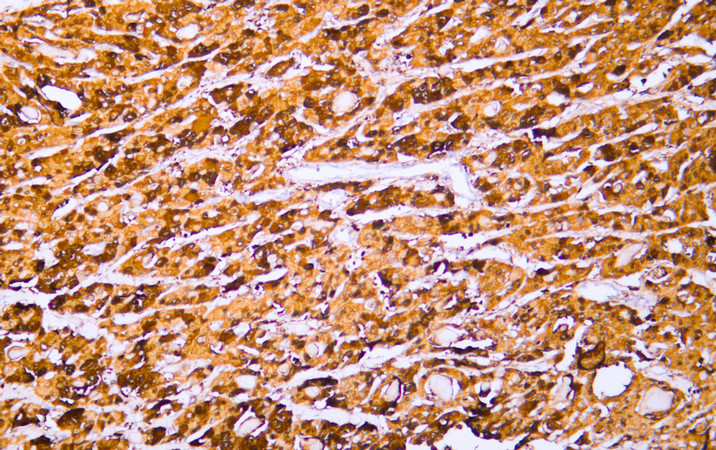Arginase-1 (ABT-Arg1) IHC kit
- Catalog No.:IHCM6684
- Applications:IHC
- Reactivity:Human;
- Target:
- Arginase I
- Fields:
- >>Arginine biosynthesis;>>Arginine and proline metabolism;>>Metabolic pathways;>>Biosynthesis of amino acids;>>Amoebiasis
- Gene Name:
- ARG1
- Protein Name:
- Arginase-1 (EC 3.5.3.1) (Liver-type arginase) (Type I arginase)
- Human Gene Id:
- 383
- Human Swiss Prot No:
- P05089
- Immunogen:
- Synthesized peptide derived from human Arginase-1 AA range: 200-322
- Specificity:
- The antibody can specifically recognize human Arginase-1 protein.
- Source:
- Mouse, Monoclonal/IgG2b, kappa
- Purification:
- The antibody was affinity-purified from ascites by affinity-chromatography using specific immunogen.
- Storage Stability:
- 2°C to 8°C/1 year
- Background:
- Arginase catalyzes the hydrolysis of arginine to ornithine and urea. At least two isoforms of mammalian arginase exist (types I and II) which differ in their tissue distribution, subcellular localization, immunologic crossreactivity and physiologic function. The type I isoform encoded by this gene, is a cytosolic enzyme and expressed predominantly in the liver as a component of the urea cycle. Inherited deficiency of this enzyme results in argininemia, an autosomal recessive disorder characterized by hyperammonemia. Two transcript variants encoding different isoforms have been found for this gene. [provided by RefSeq, Sep 2011],
- Function:
- catalytic activity:L-arginine + H(2)O = L-ornithine + urea.,cofactor:Binds 2 manganese ions per subunit.,disease:Defects in ARG1 are the cause of argininemia (ARGIN) [MIM:207800]; also known as hyperargininemia. Argininemia is a rare autosomal recessive disorder of the urea cycle. Arginine is elevated in the blood and cerebrospinal fluid, and periodic hyperammonemia occurs. Clinical manifestations include developmental delay, seizures, mental retardation, hypotonia, ataxia, progressive spastic quadriplegia.,induction:By arginine or homoarginine.,online information:Arginase entry,pathway:Nitrogen metabolism; urea cycle; L-ornithine and urea from L-arginine: step 1/1.,similarity:Belongs to the arginase family.,subunit:Homotrimer.,
- Subcellular Location:
- Nuclear, Cytoplasmic
- Expression:
- Within the immune system initially reported to be selectively expressed in granulocytes (polymorphonuclear leukocytes [PMNs]) (PubMed:15546957). Also detected in macrophages mycobacterial granulomas (PubMed:23749634). Expressed in group2 innate lymphoid cells (ILC2s) during lung disease (PubMed:27043409).
- June 19-2018
- WESTERN IMMUNOBLOTTING PROTOCOL
- June 19-2018
- IMMUNOHISTOCHEMISTRY-PARAFFIN PROTOCOL
- June 19-2018
- IMMUNOFLUORESCENCE PROTOCOL
- September 08-2020
- FLOW-CYTOMEYRT-PROTOCOL
- May 20-2022
- Cell-Based ELISA│解您多样本WB检测之困扰
- July 13-2018
- CELL-BASED-ELISA-PROTOCOL-FOR-ACETYL-PROTEIN
- July 13-2018
- CELL-BASED-ELISA-PROTOCOL-FOR-PHOSPHO-PROTEIN
- July 13-2018
- Antibody-FAQs
- Products Images

- Human hepatocelluar carcinoma tissue was stained with anti-Arginase-1(ABT-Arg1) antibody.
.jpg)
- Human hepatocelluar carcinoma tissue was stained with anti-Arginase-1(ABT-Arg1) antibody.



